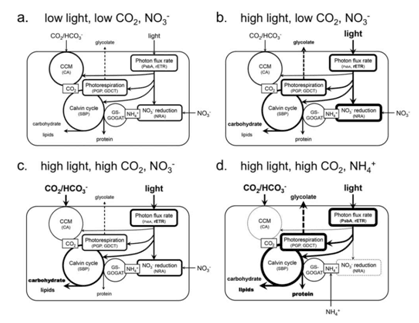作 者:Shi, D.L., Li, W.Y., Hopkinson, B.M.,Hong,H.Z., Li, D.M., Kao, S.J., and Lin, W.F. 影响因子:3.690
刊物名称:LIMNOLOGY AND OCEANOGRAPHY
出版年份:2015
卷:60 页码:1805-1822
Due to the ongoing effects of climate change, phytoplankton are likely to experience enhanced irradiance, more reduced nitrogen, and increased water acidity in the future ocean. Here, we usedThalassiosira pseudonanaas a model organism to examine how phytoplankton adjust energy production and expenditure to cope with these multiple, interrelated environmental factors. Following acclimation to a matrix of irradiance, nitrogen source, and CO2levels, the diatom’s energy production and expenditures were quantified and incorporated into an energetic budget to predict how photosynthesis was affected by growth conditions. Increased light intensity and a shift from NO3-to NH14+led to increased energy generation, through higher rates of light capture at high light and greater investment in photosynthetic proteins when grown on NH14+. Secondary energetic expenditures were adjusted modestly at different culture conditions, except that NO3-utilizationwas systematically reduced by increasingpCO2. The subsequent changes in element stoichiometry, biochemical composition, and release of dissolved organic compounds may have important implications for marine biogeochemical cycles. The predicted effects of changing environmental conditions on photosynthesis, made using an energetic budget, were in good agreement with observations at low light, when energy is clearly limiting, but the energetic budget over-predicts the response to NH14+at high light, which might be due to relief of energetic limitations and/or increased percentage of inactive photosystem II at high light. Taken together, our study demonstrates that energetic budgets offered significant insight into the response of phytoplankton energy metabolism to the changing environment and did a reasonable job predicting them.

Fig. 8.A conceptual model of the diatomT. pesudonanashowing photosynthetic energy generation (calculated as PsbA × rETR), major cellular energy expenditures (CCM, the Calvin cycle, photorespiration, and NO3-reduction), and ultimate energy sinks (carbohydrate, lipids, and protein) in response to four representative growth conditions: (a) low light, low CO2, and NO3-; (b) high light, low CO2, and NO3-; (c) high light, high CO2,and NO3-; and (d) high light, high CO2, and NH4+. Increased/decreased thickness of lines and size of arrow and font indicate increased/decreased useof the pathway.

